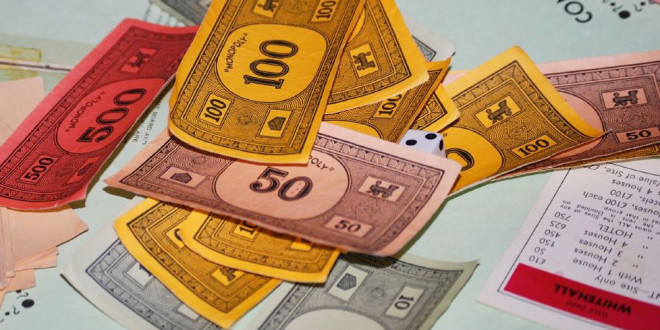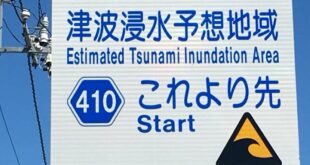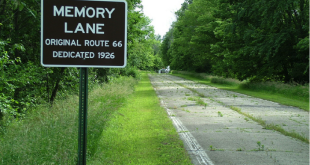The following words were written in 1976!
“To consider what is immediately practicable as well as desirable, we believe that it would be very unwise for any country or for the IMF to pursue policies (e.g. large gold sales or purchases) that would cause big fluctuations in the world gold price. In this connection the wisdom of the current gold sales by the IMF appears very doubtful. If it were certain that the world could get along permanently on paper money, the sale of gold on the private market would be the only sensible course. Since this is still very doubtful, there is much to be said for retaining official stocks, both in the IMF and in the national central banks, in case the paper system breaks down and governments are forced back, as they have so often been in the past, to a metallic standard.”
From “Gold or Paper?” by Prof. E. Victor Morgan and Ann D. Morgan
The Institute of Economic Affairs, London
And, from the Globe and Mail newspaper, June 19, 2003:
Newly appointed Federal Reserve governor Ben Bernanke mused in a speech last fall that the government has unlimited room to stimulate the economy– since it “has a technology called a printing press… that allows it to produce as many U.S. dollars as it wishes at essentially no cost.” In other words, the Fed has unlimited ammunition.
******************
Thy silver has become dross, thy wine mixed with water. Isaiah 1:22
When I was a young lad growing up in Canada, at the instigation of my father, I went to the bank every week or so and bought 1 or 2 rolls of quarters. Twenty dollars was a rather large investment to make, and the temptation was always there to blow part of it on candy, but it wasn’t as if I was spending it – I’d pull out the 4 or 5 silver quarters I found in each roll, replace them with recent date copper-nickel quarters, roll the coins back up, and take them back to the bank to exchange them for other rolls. The tellers were probably bemused by this 10-year old kid, and wondered what he was up to…
Later, in my teens, and now living in Britain, I worked the summers in a video arcade where my job was to load the change machines with 5, 10, and 50 pence pieces. Because of the high volumes of change that passed through my hands, every few days I’d find an old silver shilling, or a two shilling florin. I got so good that I could detect a silver coin in a ₤50 bag, merely by the high-pitched sound the coin would make, as I poured a bank bag into a change machine. I’d extract the old coin and replace it with a new decimal cupro-nickel piece. My boss later figured out what I was up to and put a solenoid device on the counting machine to kick out all the silver. Drat! Silver was close to $50/oz at the time and the coins were worth about 12 times face value.
Little did I know it, but I was practicing “Gresham’s Law”. Sir Thomas Gresham was a British aristocrat who founded the Royal Exchange during the reign of Elizabeth I. His pronouncement that, “When two kinds of money of equal nominal value but not in terms of demand are in circulation, the less desirable will drive the better money out of circulation”, has become a Law of Economics, because it is so obvious, universal and unquestioned – like the Law of Gravity. In my case the silver coins were driven out of circulation and into my sock drawer, as they undoubtedly were in millions of other households. Of course the mints themselves knew the same trick, and were continuously withdrawing the coins from circulation to send off to the refineries, to be melted back into ingots and eventually sold. Britain abandoned silver coinage in 1947, after more than two millennia. Their earliest coins were silver pennies, and a “pound sterling” used to be just that – a pound of silver in weight, or 240 silver pennies. Canada abandoned silver coinage in 1969. The United States threw in the towel in 1965. It had just become too expense to mint silver coins. Too expensive? How so? Were silver miners withholding the metal from markets? Was silver becoming scarce? Of course not. Inflation had devalued currencies to such an extent that it became cost-prohibitive to issue silver coins – the value of the metal contained was actually worth more than the face value of the coin itself – meaning you could make money by melting down the coins and selling metal ingots, or in my case, the coins themselves. Incredible. Such a boon for a ten year old boy! Such an easy way to make money, and risk free!
But alas, those halcyon days are over. No country in the world currently issues a silver coin that is in common circulation, though many have got in on the highly lucrative bullion coin and commemorative business.
When countries finally abandoned all precious metal coinage for common usage it indeed brought the curtain down on an era of human history. Austria, Switzerland and France were among the last to have silver coins. The event passed with little fanfare, and few people realized just what it signified. For the first time in nearly two thousand years everyone everywhere was paying for everyday articles using slugs of base metal. To find a parallel in human history one would have to go back to the darkest days of Ancient Rome.
Since the earliest days of coined money there have been counterfeiters who have faked or falsified the precious metal contents of circulating coins. As photocopy machines become increasingly sophisticated we all have become increasingly exposed to the possibility of receiving a phony banknote. I’ve had several – as you probably have – and the experience is always annoying. In olden days, crooks used to shave or clip the edges of coins and then sell the shavings to a disreputable goldsmith or silversmith. With the invention of pressing and milling machines, coins were mass produced with a motto, a laurel leaf, some other design on the coin edge, or the edge was milled as are the edges of modern coins like US quarters and dimes. This thwarted the coin clippers and put an end to the practice. Before this, it was standard for merchants to carry a set of scales and weights around with them to check the weight of coins while transacting business.
Equally dishonest was the business of “coin debasement”, which was basically the government-sanctioned “counterfeiting” of coins on a much grander scale. Governments in fiscal trouble would issue coins with a decreased content of precious metal, while maintaining the same nominal value for the coins. The metal to be coined into money would be doped with some base metal – usually copper or tin. In this way the treasury could let out a proportionally smaller amount of precious metal in each new coin issue and thus inflate the money supply. Such behavior is usually too addictive for governments to stop voluntarily, and typically governments would gleefully issue new coins with smaller and smaller contents of silver or gold while maintaining the same coin size to give the illusion that all was well. The usual conclusion of the game was to massproduce base metal tokens as proxies for money because any precious metal content in the coinage would eventually become too expensive for the government. When this endgame was reached, usually the government responsible was tottering on its last legs. All the precious metal coins had long been hoarded away and were quietly being used to make black market purchases. The people universally recognized the old money to be more valuable than the new.
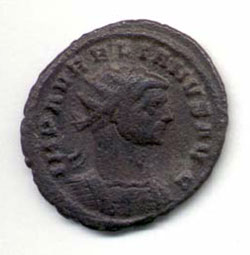 In the 3rd century A.D., the excesses of the Roman court, including the military adventures abroad (sound familiar?), could only be paid for by inflating the money supply through coin debasement. Taxation could not do the job alone. The most common coin was the “Antoninianus”, which, when it first came into circulation in 215 A.D. represented one day’s pay for a Roman soldier. Within 50 years, successive usurpers to the title of Emperor had reduced the silver content of the Antoninianus from its original pure silver content, to “billion”, by which time the coin only bought a loaf of bread. Billion is the term used for copper which contains only about 5% silver. In order to give the illusion that the money was still “good”, the mint masters hit upon a clever idea used by silversmiths: the billion coins were heated in a furnace to oxidize the copper component on the surface of the coins. This copper oxide was then stripped away in an acid bath. After a few rounds of heating and pickling in acid the silver would be brought to the surface of the coin in a thin rind, and give the coin a brilliant silvery appearance. No slouches these Romans! After a year of wear the thin rind would be worn away as it was from this coin (left). Near the end of the 3rd century some regional mints were coining over a million Antoninianus a year. They had to. Merchants had wised up to the fact the money was virtually worthless and so prices were skyrocketing. Huge amounts of coins needed to be minted to keep up with the demand by the populace. If the cost of bread went from say 1 Antoninianus to 100, it’s obvious that more coins were needed to buy out the bakery by lunchtime. Eventually, even the pretence of a silver content was dropped and the Antoninianus was issued in bronze. Prices of bread and wine soon went beyond the reach of the average citizen. Draconian wage and price controls were introduced, but it only resulted in driving the economy underground where primitive barter started to take over. The situation got so bad that Romans talked about letting the Goths invade – at least their money was good! The runaway inflation was only stopped when the Antoninianus was finally discontinued by Diocletian, and the money reformed in 294 A.D.
In the 3rd century A.D., the excesses of the Roman court, including the military adventures abroad (sound familiar?), could only be paid for by inflating the money supply through coin debasement. Taxation could not do the job alone. The most common coin was the “Antoninianus”, which, when it first came into circulation in 215 A.D. represented one day’s pay for a Roman soldier. Within 50 years, successive usurpers to the title of Emperor had reduced the silver content of the Antoninianus from its original pure silver content, to “billion”, by which time the coin only bought a loaf of bread. Billion is the term used for copper which contains only about 5% silver. In order to give the illusion that the money was still “good”, the mint masters hit upon a clever idea used by silversmiths: the billion coins were heated in a furnace to oxidize the copper component on the surface of the coins. This copper oxide was then stripped away in an acid bath. After a few rounds of heating and pickling in acid the silver would be brought to the surface of the coin in a thin rind, and give the coin a brilliant silvery appearance. No slouches these Romans! After a year of wear the thin rind would be worn away as it was from this coin (left). Near the end of the 3rd century some regional mints were coining over a million Antoninianus a year. They had to. Merchants had wised up to the fact the money was virtually worthless and so prices were skyrocketing. Huge amounts of coins needed to be minted to keep up with the demand by the populace. If the cost of bread went from say 1 Antoninianus to 100, it’s obvious that more coins were needed to buy out the bakery by lunchtime. Eventually, even the pretence of a silver content was dropped and the Antoninianus was issued in bronze. Prices of bread and wine soon went beyond the reach of the average citizen. Draconian wage and price controls were introduced, but it only resulted in driving the economy underground where primitive barter started to take over. The situation got so bad that Romans talked about letting the Goths invade – at least their money was good! The runaway inflation was only stopped when the Antoninianus was finally discontinued by Diocletian, and the money reformed in 294 A.D.
The debasing of money is always a sign of a government in trouble. But with the total abandonment of precious metals for a wholly fiat currency – that is, one that is in no way tied in value to or redeemable in precious metal – all fiscal restraint goes out the window and governments are free to inflate the currency at will. Inflation remains the most insidious of taxes – many people don’t realize that commodities are not really increasing in price; rather, the purchasing power of their currency is dropping. The point is a subtle but important one. In U.S. history, paper money has become worthless or near worthless several times – the “Continentals” of the War of Independence and shortly thereafter; the “Greenbacks” of the Civil War printed by the Union; and the money printed individually by southern states and the Confederacy.
 The most infamous case of the printing press gone awry is that of the Weimar government of Germany in 1923. Below are the front and back of an “Ein Hundert Milliarden Mark” note. How much is this? An astounding 100,000,000,000 marks! Eleven zeros! Small denomination notes had been demonetized over the previous several years – there was nothing to buy with them and they were a nuisance. This note, on the day of introduction was worth about $100, but started to lose value in almost geometrical progression immediately. Within a few days it would barely purchase a loaf of bread. See that it is printed on one side only – this was partially to cut down the costs of printing, but more importantly, to decrease the time needed to print the note so it could be got out the door and in circulation faster! Amazingly, this was not even the largest note! Larger denominations came only a few weeks after this, but within a little more than a month after the note above was printed the whole German monetary system came crashing down. 1,000,000,000,000 old marks were declared equal to a new “Rentenmark” or one old gold mark, but by this time, most of the gold marks had gone abroad. Miraculously, and probably due to sheer exhaustion, the new currency took and was accepted, but only after the mark had completely, utterly, collapsed in value causing financial mayhem and the erasure of most personal savings. This whole situation sounds pretty pathetic huh?
The most infamous case of the printing press gone awry is that of the Weimar government of Germany in 1923. Below are the front and back of an “Ein Hundert Milliarden Mark” note. How much is this? An astounding 100,000,000,000 marks! Eleven zeros! Small denomination notes had been demonetized over the previous several years – there was nothing to buy with them and they were a nuisance. This note, on the day of introduction was worth about $100, but started to lose value in almost geometrical progression immediately. Within a few days it would barely purchase a loaf of bread. See that it is printed on one side only – this was partially to cut down the costs of printing, but more importantly, to decrease the time needed to print the note so it could be got out the door and in circulation faster! Amazingly, this was not even the largest note! Larger denominations came only a few weeks after this, but within a little more than a month after the note above was printed the whole German monetary system came crashing down. 1,000,000,000,000 old marks were declared equal to a new “Rentenmark” or one old gold mark, but by this time, most of the gold marks had gone abroad. Miraculously, and probably due to sheer exhaustion, the new currency took and was accepted, but only after the mark had completely, utterly, collapsed in value causing financial mayhem and the erasure of most personal savings. This whole situation sounds pretty pathetic huh?
Fast forward to the United States of America, circa 2003:
The heads of the Bundesbank in 1923 would never have thought that a time would come when most of the governments of the world couldn’t even afford to issue low denomination paper currency. In the 1980’s, Canada, Australia and Great Britain began to replace their paper dollars and pounds with base metal slugs. Why? The costs of replacing the entire issue of paper money every year or so were becoming prohibitively expensive; particularly for the small denomination notes. Banks would turn in heavilysoiled or torn notes to the treasury, which would replace them with fresh crisp new notes. Remember the 1963 Great Train Robbery in Britain? That was a hijacked shipment of old banknotes on its way to be burned. As the paper money issue has become ever larger due to inflation, the respective mints have had to reissue more and more paper money to replace worn out notes. The solution? Go to more durable coins, which should last a minimum of 20 or 30 years. Brilliant! The United States flirted with this idea a few years back and introduced the Susan B. Anthony dollar coin – but it was a huge flop, because it was a similar size to the quarter dollar coin and a silvery color like a quarter. The design on the coin was also considered not very aesthetic. Large caches of Susan Anthony dollars languished away in bank vaults, unused. The Canadian and British governments learnt through the experience and issued brass-colored dollar coins that could not be mistaken for any existing coins. They also chose to pull all existing dollar bills and pound notes from circulation to force their people to use the coins.
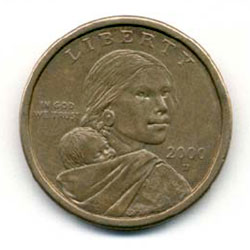 The Sacagawea “Golden” Dollar is the latest attempt by the U.S. government to finally retire George Washington’s portrait. On the U.S. Mint’s official website the “Golden” (their adjective, not mine) dollar is listed to contain a cocktail of 88.5% copper, 6% zinc, 3.5% manganese, and 2% nickel. Those who thought it might contain a trace of gold will be disappointed…..not even a hint. The Sacagawea dollar has been aggressively marketed to Americans, but it too has failed. A dollar is not what it was, and many Americans don’t feel too bad about hoarding away a dollar coin as a curiosity. The Federal Government is still reluctant to withdraw paper dollars, because they see the move as politically unpopular. Countless millions of Sacagawea dollars have been minted though….what to do with them?
The Sacagawea “Golden” Dollar is the latest attempt by the U.S. government to finally retire George Washington’s portrait. On the U.S. Mint’s official website the “Golden” (their adjective, not mine) dollar is listed to contain a cocktail of 88.5% copper, 6% zinc, 3.5% manganese, and 2% nickel. Those who thought it might contain a trace of gold will be disappointed…..not even a hint. The Sacagawea dollar has been aggressively marketed to Americans, but it too has failed. A dollar is not what it was, and many Americans don’t feel too bad about hoarding away a dollar coin as a curiosity. The Federal Government is still reluctant to withdraw paper dollars, because they see the move as politically unpopular. Countless millions of Sacagawea dollars have been minted though….what to do with them?
In April of 2000, the government of the tiny South American nation of Ecuador abandoned their currency, the Sucre, in favor of total adoption of the U.S. buck. In the late 1990’s the largely agrarian economy of Ecuador was devastated by the El Niño weather event. In 1998 and 1999, mighty storms rolled in from the Pacific, utterly destroying the banana crop and shrimp fishery; after oil, the country’s #2 and #3 export earners. Through the inevitable domino effect of such an unprecedented natural disaster, 7 banks failed, laying waste to the economy of the country and spawning an Argentinestyle hyperinflation. The solution taken was not to peg the Sucre to the dollar, but abandon the local currency altogether. The move was a good one, since it stopped the bleed and allowed the country to restructure. I currently live in Ecuador, and this is where the story comes almost full circle…
Ecuadorians have no prejudice against using the new dollars, and in the last few months huge numbers of the unwanted coins have been shipped from the U.S. to the Central Bank of Ecuador for distribution. There are information brochures about the coin posted everywhere. Not long ago I received a cunning fake in pocket change that looked identical to the real McCoy, except it lacked the telltale copper stripe along the coin edge. Now, you may ask, why would anyone bother to go to the trouble of faking a dollar coin? Obviously, if it’s just a metal slug with no intrinsic value it should be possible to fake it for mere pennies. I’m sure it doesn’t cost the U.S. mint itself much more than that. This is probably the first time in a generation (maybe two or three) that crooks have gone to the trouble of faking a U.S. coin in common circulation. Will fake Sacagaweas drive out the paper dollar? It’s doubtful that the situation will get that bad, and in any case there is a seemingly limitless supply of readily available paper courtesy of the US Fed not too far away. I got to thinking, really what’s the moral difference between a couple of guys skilled with tool and die in the backroom of a workshop somewhere in Latin America versus another couple of rascals in D.C. wearing pinstripes who want to print a mountain of notes to goose the economy because they’ve been fiscally irresponsible? But I digress…
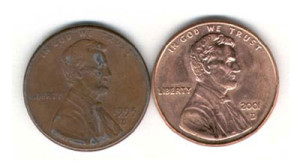 As an interesting sidebar to this story, if you’re American you may wonder why pennies don’t jingle in your pocket these days the way they used to. Up to 1982, American one cent pieces were 95% copper and 5% zinc. The zinc was added only to make the coin harder so it would be more resistant to wear. After 1982, the U.S. Mint began to clad zinc slugs with a copper coating, to give an overall content to the coins of 97.5% zinc and 2.5% copper. Take a pre-1982 penny and drop it on the floor or a tabletop. You’ll hear a pleasant high pitched ring. Now try it with a new penny. You’ll hear a dull thud. It’s now too expensive even to make copper pennies. There’s talk of demonetizing the penny altogether. It’s been around for the whole 227 years of the United States – and for most of that time it actually bought something.
As an interesting sidebar to this story, if you’re American you may wonder why pennies don’t jingle in your pocket these days the way they used to. Up to 1982, American one cent pieces were 95% copper and 5% zinc. The zinc was added only to make the coin harder so it would be more resistant to wear. After 1982, the U.S. Mint began to clad zinc slugs with a copper coating, to give an overall content to the coins of 97.5% zinc and 2.5% copper. Take a pre-1982 penny and drop it on the floor or a tabletop. You’ll hear a pleasant high pitched ring. Now try it with a new penny. You’ll hear a dull thud. It’s now too expensive even to make copper pennies. There’s talk of demonetizing the penny altogether. It’s been around for the whole 227 years of the United States – and for most of that time it actually bought something.
On the right we have a brand new shiny penny. On the left, an example a mere 8 years old and already the zinc is showing through Honest Abe’s forehead due to wear. Pathetic huh?
There are several countries in the world that now rely exclusively on paper money for everyday transactions and it is probably only a matter of time before most countries of the world follow suit and even small denomination notes disappear. Some governments want us to move exclusively to debit cards. But we expect the time will come around again, like it did for the Roman aureus, the British sovereign, the Byzantine bezant – or the Austrian Trade Thaler, the Spanish doubloon, or the good old American silver dollar – each in turn had its day in the sun as an internationally accepted medium of exchange in commerce. Perhaps we’ll even get a real gold dollar instead of an ersatz one. Sound money will again prevail and be accepted without question, and that money will without doubt be made of gold and silver. The country that issues sound currency will surely enjoy the stability and prosperity of these now vanished empires.
Where there’s muck there’s brass.
There’s an old Yorkshire saying – “Where there’s muck there’s brass” – “brass” being slang for money. Here’s a bit of interesting arcana for you:
I remember in the early 1980’s a company made significant “brass” extracting gold from the unlikeliest of materials – sewage sludge. In Toronto, sewage sludge from the treatment plant – mostly from human waste – had been routinely incinerated for years and then dumped down at the Leslie Street spit into Lake Ontario. The company took a portable extraction plant down to the spit and excavated the ash from the lakebed for some months. I remember they were mining material that was higher grade per ton in gold than was at that time mined from the Pamour gold mine in Timmins, Ontario. I also remember that inexplicably the grade dropped to zero one day, and it was only later realized that the heavy equipment operator had dug too deeply and was excavating normal lake bottom sediment. It’s been too many years for me to easily dig up a news story about it, but I found a more recent reference in the Northern Miner (April 18, 1988) which quoted grades as high as 0.15 oz/T gold and 8 oz/T silver from ashed Toronto sewage sludge.
All this was triggered when I recently came across an article in the Journal of Geochemical Exploration 65 (1999) 141-153 by Shane Reeves, Ian Plimer and David Foster, entitled “Exploitation of gold in a historic sewage sludge stockpile, Werribee, Australia: resource evaluation, chemical extraction and subsequent utilization of sludge.”
Okay, the obvious question: Where does the gold come from? The answer is that no one really knows, but it looks like bacteria and other microorganisms that feed on the nasty stuff that swirls down the bowl are able to capture metals on their cell surfaces. Theory goes that lots of bacteria equals a high concentration of metals. Bacteria found in mine waste ponds are able to armour themselves in metal particles. Another possibility is that the organic carbon present in the end-products of bacterial digestion is actually able to fix gold through adsorption, much like the activated carbon used in carbon-in-pulp gold recovery systems at many gold mines. Maybe the ultimate source of the gold is industrial waste-water or, maybe it’s millions of housewives washing their hands with their wedding rings on. The journal article discusses the mining of waste from the city of Melbourne at Werribee, which had accumulated in a lagoon for almost a hundred years. The Measured Resource was 0.77 g/t gold, 18.8 g/t silver, and 1.18 kg/t zinc for a volume of 770,000 cubic metres. These are pretty incredible numbers, but I wouldn’t want to be the geologist doing the sampling!
Show and Tell
My nine-year old niece recently wowed her classmates at school with a practical demonstration of the differences between “Fools Gold” (iron pyrite) and Real Gold. When the two are put side-by-side there’s no mistaking the real thing; pyrite being brassy in colour while gold of course is…well…golden in colour, with a warmth and shine that can’t be mistaken. She brought a small piece of pyrite (from Peru) and a small gold nugget (courtesy of Uncle Keith’s collection) to school, along with two normal carpenter’s hammers. She had to turn the hammers into the teacher as soon as she got to school since they were considered “weapons” (oh what sad times we live in!), but was able to retrieve them for the demonstration. She first took a piece of the pyrite, and placed it on the flat side of one of the hammers to use as an anvil. She then smartly smacked the pyrite with the other hammer, to produce a small pile of greenish-black powder. Then she took the small nugget and repeated the process. With little effort she was able to flatten the gold nugget into a small pancake, which she could peel off the hammer and pass around the class. Thus demonstrating two fundamental mineral properties: gold is malleable, while pyrite is brittle. It was with a bit of pride I heard that she received 20 questions; a class record for a “science demonstration”. When I find gold in the pan in the field I often will take the small grains of gold and flatten them against a hammer by pressing down on them with the bowl of a spoon. It’s the same principal – if they flatten out I know they’re gold. Gold leaf used in gilding is made in much the same way.
Scam Protection
Here’s something interesting I came across recently…
“The authors comment on recent so-called “desert dirt” scams, pointing out that interferences associated with the Fe ingot technique when coupled with the ICP-OES or DCP-OES finishes that are normally used by the “certified” analysts employed in these cases render the results worthless. For example, the authors calculate that a U.S. nickel coin, when analyzed in this way and not corrected for interferences, appears to contain enough Pt, Pd, Rh, and Ir to give it an inherent value of $15.00!”
This is from a book review by Prof. Tony Naldrett, which appeared in the scientific journal “Economic Geology”. The excerpt is from The Geology, Geochemistry, Mineralogy and Mineral Beneficiation of Platinum-Group Elements, Canadian Institute of Mining and Metallurgy Special Volume 54 by Louis Cabri
N.B.: for those interested, ICP-OES is inductively coupled plasma optical emission spectroscopy, and DCP-OES is direct current argon plasma emission spectroscopy.
I know of at least one active desert dirt scam from California where platinum and other precious metals are being “assayed” from “volcanic cinders”. As is typical for Desert Dirts, the perpetrators are assaying the samples themselves, instead of sending them to an accredited laboratory. The most common methods of assaying for platinum, palladium, and other PGE’s (platinum group elements, also referred to as PGM’s; platinum group metals) used by legitimate labs are lead fire assay or nickel sulphide fire assay.
——-
This “Straight Talk” marks the one year anniversary of my last “blog”. But I haven’t been on a Jimmy Rogers-type sabbatical, touring the world – I’ve been busy. Many of you will know that over the last couple of years I have been assembling a gold exploration project in Ecuador. Back some time ago I came to the realization that the best way that I could personally leverage myself to the gold price was to go forth and find the stuff. As a professional geologist I am blessed with the skills to do just that. And so, I have been very much putting my money where my mouth is, and rather than just writing about gold I’ve been out in the jungle cracking rocks and panning in streams. In future Straight Talks I’ll talk a bit more about the exploration process, but you’ll have to forgive me if my commentaries come out on an irregular basis – I’ve still lots to do!
I welcome you to visit the Straight Talk on Mining website at http://www.straighttalkonmining.com
All the old commentaries back to creation (S.T.O.M creation that is) are there for your viewing pleasure. There’s lots of good stuff there. Send us your E-mail address and we’ll let you know when something new gets posted.
 Straight Talk On Mining Insights on mining from economic geologist Dr. Keith Barron.
Straight Talk On Mining Insights on mining from economic geologist Dr. Keith Barron.
